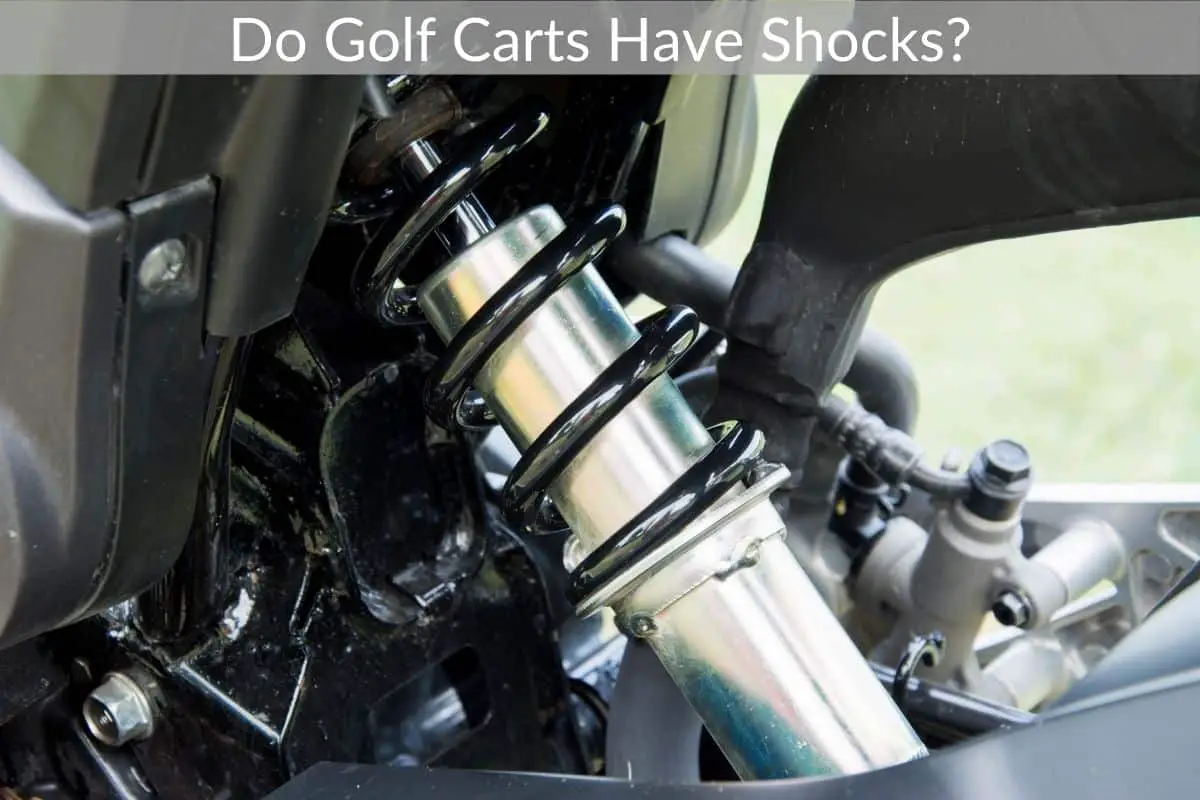Table of Contents
*This post may contain affiliate links. As an Amazon Associate we earn from qualifying purchases.
The comfort and smoothness of any vehicle depends highly on its ability to reduce the number and frequency of shocks from the ground. Shock absorbers do this with the help of well-oiled springs that compress and extend according to the terrain below and ensure a smooth ride all the way.
Golf carts aren’t like your traditional vehicle, though, and so a question arises. Do golf carts have shocks or do they use a different method to ensure a smooth drive? Where are these shocks, and how can you take care of them?
This article will take a closer look at golf cart shocks and help you learn more about them.
To see some of the latest and greatest golfing gadgets currently on the market just click here.
Do Golf Carts Have Shocks?
Golf carts do have shock absorbers.They use shock absorbers and leaf springs to absorb the impact of any debris underneath the cart, giving everyone on the cart a better experience, even on rough terrain.
It is important to note that the shocks in a golf cart aren’t designed to eliminate bumps but to smooth them out.
Usually, more expensive golf carts have heavy-duty golf cart shocks (or leaf springs) and last longer than traditional ones. Even on poorly constructed cart paths, these shocks can keep your cart straight and eliminate the risk of your suspension sagging.
You know that rough feeling your cart’s steering wheel gives out, or how hard it gets when you try to turn the wheel without moving? Heavy-duty cart suspensions are designed specifically to eliminate this rough feeling known as suspension sagging.
Under normal use, good-quality golf cart shocks can last anywhere from 50,000 miles to 100,000 miles. This figure can increase or decrease, depending on how you use your cart. For example, if you don’t keep the shock absorbers well-maintained or don’t slow down even on rough patches, the shocks will, of course, suffer.
Although shocks don’t have any bearing on the engine’s performance directly, faulty or broken shocks can severely affect your golfing experience, not to mention your stamina. The smooth ride gives your body some time to rest.
Instead, if your body still has to experience golf cart vibrations, your muscles will tire out much more quickly.
Testing Golf Cart Shocks
To test your golf cart shocks, you need to check three very important things.
1. The feel. You want your cart to be relatively bouncy as you climb into it or when hitting a bump in the road. If the cart struggles to bounce and instead gives you “thudding” feels and sound, your shock absorbers may have rust in them or not be oiled properly anymore.
2. The sound. If you hear a thudding sound when you hit a bump along with the feel each time you hit a pebble in the road, you may have rust. However, if you hear a squeaking noise as you drive over rough terrain, your shocks may need to be oiled again. You may need to head back to the clubhouse or mechanic for this.
3. The look. And finally, conduct a visual inspection of the shocks to make sure no oil is leaking. Leaking oil means damaged shocks, and over time you may start losing out on the smoothness.
Golf cart shocks can also be used to ‘lift’ the cart, which is known for improving cart efficiency but, at the same time, introducing a risk of the cart rolling over.
Are Lifted Golf Carts Faster?
As mentioned above, golf cart shocks can be adjusted to ‘lift’ the cart up. You should only consider this if you can handle the risk of the cart turning over and are a veteran driver. The goal of lifting golf carts is to increase their speed.
You can install some lift kits on golf cart shocks. However, if you don’t want to increase the risk of rolling over but at the same time get a taller, faster ride, you can go for larger tires.
The tires are more expensive than the lift kits, but these kits aren’t exactly cheap, either.
It is important to note that a normal golf cart can go up to 15-20 mpg, while with lift kits, you can expect your cart to go beyond 25mph to even 40 mph easily. Be very careful on the greens at this speed, as golf tires may slip if spinning too fast.
Consider replacing your golf cart shocks when you start noticing sagging, or the current shocks have gotten extremely hard. If you let the shocks be, something may get damaged within the cart, or the wheels may even start rubbing against the wheel walls under extreme conditions!
Remember, it is common for golf cart shocks to go through normal wear and tear. The primary factors you may need to change these shocks are age or usage. If you have a lot of hard terrain and poorly maintained cart paths, you should consider buying a heavy-duty suspension pair.
You can find golf cart shocks quite easily by simply looking underneath the cart from the front or the back. It is easier to find the rear shocks in many models because the bumper may cover the front shocks.
If you want to replace your golf cart shocks or conduct routine maintenance, you will have to get your hands dirty. Either crawl under the cart or lift it with a forklift to work on it. Usually, the rear springs are useful for heavier loads, while the front shocks are more geared towards driver and passenger comfort.
Some considerations to make when you are searching for new golf cart shocks include:
• Whether or not the golf cart shocks are easy to install. For some, there is a snap-and-roll mechanism, while it may not be as straightforward for others.
• Spring strength
• Its ability to handle torque. It is best to go over customer reviews for this.
• The shape. Ach-shaped shocks are more useful for making the ride more pleasant.
• Brushings. These little brushes go a long way in helping you prolong the life of your shocks. If you ever find that the shocks are getting hard, you can change the brush and get that ‘new shocks’ feeling.
Golf cart shocks need to be maintained regularly because of the terrain it drives in. Consider getting it checked (or doing it yourself) once every 2 months, oiling the shocks, and ensuring there is no damage.

